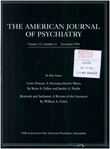Late luteal phase dysphoric disorder in 670 women evaluated for premenstrual complaints
Abstract
OBJECTIVE: The American Psychiatric Association's DSM-IV Work Group on Late Luteal Phase Dysphoric Disorder (LLPDD) reanalyzed existing data from prospective, daily symptom ratings to evaluate the DSM-III-R criteria for LLPDD. The objectives were to 1) evaluate the individual symptoms presently required for the diagnosis and other symptoms, 2) determine the proportion of treatment-seeking women who meet the LLPDD criteria, and 3) explore the association between LLPDD and other mental disorders. METHOD: Data from over 1,000 women seeking evaluation for premenstrual complaints at five U.S. sites were examined. The data from 670 of these women were sufficiently complete to warrant evaluation by four different methods of assessing symptom change. RESULTS: Depending on the assessment method used, 14% to 45% of the women met the criteria for LLPDD. The current DSM-III-R symptoms were classified as positive for 7% to 54% of the women. Each of these symptoms was significantly more common among women with LLPDD regardless of the assessment method used. Five symptoms not presently included were also significantly more common. Women who had had mental disorders in the past, but not present, showed a significantly greater, but very small, relative risk of LLPDD. CONCLUSIONS: The variability in the frequency of LLPDD diagnosis according to method of assessing symptom change underscores the need for a uniform assessment method. The five additional symptoms with frequencies comparable to those of the DSM-III-R symptoms should be studied further for possible inclusion in the criteria.
Access content
To read the fulltext, please use one of the options below to sign in or purchase access.- Personal login
- Institutional Login
- Sign in via OpenAthens
- Register for access
-
Please login/register if you wish to pair your device and check access availability.
Not a subscriber?
PsychiatryOnline subscription options offer access to the DSM-5 library, books, journals, CME, and patient resources. This all-in-one virtual library provides psychiatrists and mental health professionals with key resources for diagnosis, treatment, research, and professional development.
Need more help? PsychiatryOnline Customer Service may be reached by emailing [email protected] or by calling 800-368-5777 (in the U.S.) or 703-907-7322 (outside the U.S.).



